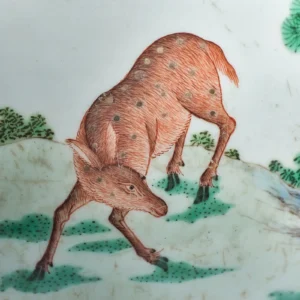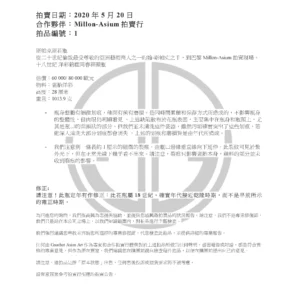Yangcai’ famille rose porcelain vase,
CHINA - 18th century
Estimate : 60 000 - 80 000 €
Sold 255 000 €
An important vase in ‘Yangcai’ famille rose porcelain, the rounded body resting on a short, slightly flared foot and rising delicately to a high, narrow neck finished in the shape of a bulb, the delicately raised rim is enhanced with gold, characteristic of pieces of the highest quality destined for the collections of the Imperial Palace and the highest dignitaries.
The body is adorned with a delightful continuous scene decoration featuring fallow deer and cranes in a rocky landscape. The fallow deer, or ‘Lu’ in Chinese, is the homophone of emolument, symbolizing prosperity, longevity and grace. The crane, with its long life expectancy, is a symbol of longevity, again by homophony, and also of social advancement. Bats, ‘bian fu’, are themselves a homophone of the Chinese word ‘fu’ (happiness). They are reputed to live to a ripe old age and are a symbol of joy, longevity and prosperity.
Among the many symbols carefully selected for this vase’s decorative composition is the immortality pine, which never loses its foliage and remains green in all seasons, reflecting the life that never dies in winter and thus becoming the promise of spring to come.
Last but not least, lingzhi mushrooms have been added to the edges of rocky massifs. This is an emblematic mushroom that serves as food in the ‘paradise of the immortals’, and whose shape will inspire the design of ruyi scepters for centuries to come.
Height: 28 cm
Parallels and provenance :
The Sparks vase: From the hands of Captain John Sparks, one of London’s most renowned Asian Art dealers of the 20th century, to the Millon auction house in Paris.
Another vase recently sold at auction in Paris (cf. Sotheby’s June 12, 2018, lot 1), with a more elaborate, detailed decoration and enhanced by a Qianlong emperor’s mark under the base, is very similar to the ‘Sparks’ vase in shape. The decoration on the neck and the landscape are similar, although they display features typical of the ‘over-decoration’ fashionable during the reign of the Qianlong emperor.
This copy, sold in 2018, had itself been compared at auction to a better-known copy originally in the prestigious Ernest Grandidier (1833-1912) collection, donated to the Louvre in 1894 and then transferred to the Guimet Museum since 1945 (see Image 2).
The decoration on the vase presented today, relatively free and more widely spaced than on the two parallels, the neck free of any sgraffiato decoration (a characteristic decoration added to the repertoire of Jingdezheng potters during the Qianlong period to enrich the decoration on porcelain and give it a baroque look from the West) but rather enhanced by bats, The composition, imbued with heavy Chinese symbolism, and the lighter tonal palette than used on the two equivalents, suggest a slightly earlier date.
– John Sparks LTD, London (label under the base)
– Private collection, Brussels. Purchased in London from John Sparks LTD. by the current owner’s grandfather in the 1950s and in the same family ever since.
Yangcai’ famille rose porcelain vase, - CHINA - 18th century

Yangcai’ famille rose porcelain vase, - CHINA - 18th century
Other results obtained by Asium
The Asium estimation service is...

Simple
and free
A few photos of your work, a few words of description and you're all set !

Fast
but not too fast
Our experts are serious, they take the time to research and get back to you within a week.

Reliable
and confidential
Our auctioneers are the Sherlock Holmes of the art market.












